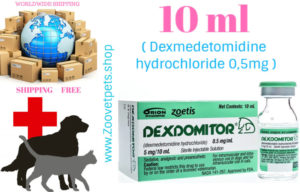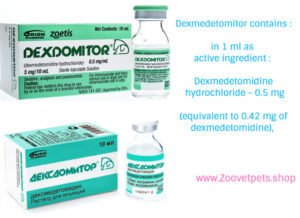Description
Full description
Instructions for the use of Dexdomitor® for sedation and analgesia in dogs and cats.
I. General information
Trade name of the medicinal product: Dexdomitor. International non-proprietary name: dexmedetomidine.
Dosage form: injection solution.
In appearance, the drug is a clear, colorless liquid. The shelf life of the drug Dexdomitor, subject to storage conditions in the manufacturer’s sealed packaging, is 3 years from the date of production, after the first opening of the bottle – 28 days, after mixing in one syringe with ketamine and / or butorphanol – no more than 2 hours.
Do not use Dexdomitor® after the expiration date.
They produce Dexdomitor with 0.1 mg / ml dexmedetomidine content in 15 ml glass vials, Dexdomitor with 0.5 mg / ml dexmedetomidine content in 10 ml glass vials, sealed with rubber stoppers, reinforced with aluminum caps, equipped with plastic caps for controlling the first opening. Vials are packed in individual cardboard boxes along with instructions for use.
Dexdomitor is stored in closed manufacturer’s packaging in a dry place protected from direct sunlight, separately from food and feed at a temperature of 2 ° C to 25 ° C.
Dexdomitor is kept out of the reach of children.
Dispose of unused product in accordance with legal requirements.
Vacation conditions: dispensed without a veterinarian’s prescription.II. Pharmacological properties
Dexdomitor belongs to the pharmaceutical group of α2-adrenergic receptor agonists.
Dexmedetomidine, which is part of the drug Dexdomitor, is a potent selective α2-adrenergic receptor agonist, the main action of which is to inhibit the transmission of nerve impulses in adrenergic synapses by competing with norepinephrine.
Under the action of the drug in animals, depression of the central nervous system and an increase in the pain threshold develop.
The effect of dexmedetomidine is dose dependent: small doses have moderate sedation without analgesia, while high doses
cause significant sedation and analgesia.
Dexdomitor is well absorbed after injection, quickly distributed in the body and easily crosses the blood-brain barrier. The concentration of the drug in the blood reaches a maximum after 15-30 minutes. More than 90% of the drug binds to blood plasma proteins. The half-life in dogs is 40-50 minutes, in cats – 60 minutes.
Dexmedetomidine is metabolized in the liver and excreted primarily by the kidneys.
According to the degree of effect on the body, the active substance of the drug dexmedetomidine belongs to the 2nd hazard class – highly hazardous substances (according to GOST 12.1.007).III. Application procedure
Dexdomitor is used to obtain sedation and analgesia in dogs and cats during surgical operations, various clinical studies, as well as to prevent aggressive animals. It is recommended to use the premedication medication under general anesthesia.
Contraindications to the use of Dexdomitor are hypersensitivity to the drug’s components, severe systemic diseases, heart failure, liver or kidney dysfunctions, pregnancy and lactation, the age of dogs under 4 months old and cats under 3 months old.
Dexdomitor is administered intravenously or intramuscularly to dogs, intramuscularly to cats.
The dose of the drug is chosen depending on the desired effect, individual characteristics and breed of animal. High doses cause pronounced sedation and analgesia, low doses only have a sedative effect. Small breed dogs require a higher dose of the drug than large dogs.
The use of dexmedetomidine as a sedative in dogs and cats significantly reduces the amount of drug needed to induce anesthesia, so intravenous anesthetics should be administered with caution and the condition of the animal should be closely monitored.
The amount of inhaled anesthetics to maintain anesthesia is also reduced.
To achieve sedation and analgesia, Dexdomitor with a dexmedetomidine content of 0.1 mg / ml is used in the following doses: for
dogs – 0.5-2.0 ml / 10 kg of body weight;
cats – 0.5 ml / kg body weight.
To achieve a sedative effect and analgesia, Dexdomitor with a dexmedetomidine content of 0.5 mg / ml is used in the following doses: for
dogs – 0.1-0.8 ml / 10 kg of body weight;
cats – 0.1 ml / kg body weight.
Doses of dexmedetomidine in dogs are calculated per unit of body surface area (μg / m2):
intravenously up to 375 μg / m2 of body surface area;
intramuscularly up to 500 μg / m2 of body surface area.
When administered together with butorphanol (0.1 mg / kg) for deep sedation and analgesia, the intramuscular dose of dexmedetomidine is 300 μg / m2 body surface area.
The dose of dexmedetomidine as a drug for premedication is 125-375 μg / m2 body surface area, it is administered 20 minutes before induction for procedures requiring anesthesia. The dose should be adjusted depending on the type of surgery, the duration of the procedure, and the temperament of the animal.
The combined use of dexmedetomidine and butorphanol gives sedative and analgesic effects, starting no later than 15 minutes after administration. The maximum effects of sedation and analgesia are achieved within 30 minutes after administration. Sedation lasts for at least 120 minutes after administration, and analgesia for at least 90 minutes. Full recovery of consciousness occurs within 3 hours.
Premedication with dexmedetomidine significantly reduces the dose of inducing agent needed and reduces the amount of inhaled anesthetic to maintain anesthesia. To achieve anesthesia, together with propofol and thiopental, their doses are reduced by 30% and 60%, respectively. Dexmedetomidine contributes to the achievement of postoperative analgesia within 0.5-4.0 hours, but this period depends on a number of factors, and the next dose of analgesics should be administered in accordance with clinical judgment.
Doses based on dog weight are shown in the following tables. The use of a calibrated syringe is recommended to ensure accurate dosing for small volumes.
Doses of the drug Dexdomitor with a dexmedetomidine content of 0.1 mg / ml for dogs for premedication:
| Dog weight (kg) | Dexmedetomidine 125 μg / m 2 | Dexmedetomidine 375 μg / m 2 | Dexmedetomidine 500 μg / m 2 | |||
| (μg / kg) | (ml) | (μg / kg) | (ml) | (μg / kg) | (ml) | |
| 2-3 | 9.4 | 0.2 | 28.1 | 0.6 | 40 | 0.75 |
| 3-4 | 8.3 | 0.25 | 25 | 0.85 | 35 | 1 |
| 4-5 | 7.7 | 0.35 | 23 | 1 | thirty | 1.5 |
| 5-10 | 6.5 | 0.5 | 19.6 | 1.45 | 25 | 2 |
| 10-13 | 5.6 | 0.65 | 16.8 | 1.9 | ||
| 13-15 | 5.2 | 0.75 | ||||
| 15-20 | 4.9 | 0.85 | ||||
| Dog weight (kg) | Dexmedetomidine 125 μg / m 2 | Dexmedetomidine 375 μg / m 2 | Dexmedetomidine 500 μg / m 2 | |||
| (μg / kg) | (ml) | (μg / kg) | (ml) | (μg / kg) | (ml) | |
| 2-3 | 9.4 | 0.04 | 28.1 | 0.12 | 40 | 0.15 |
| 3-4 | 8.3 | 0.05 | 25 | 0.17 | 35 | 0.2 |
| 4-5 | 7.7 | 0.07 | 23 | 0.2 | thirty | 0.3 |
| 5-10 | 6.5 | 0.1 | 19.6 | 0.29 | 25 | 0.4 |
| 10-13 | 5.6 | 0.13 | 16.8 | 0.38 | 23 | 0.5 |
| 13-15 | 5.2 | 0.15 | 15.7 | 0.44 | 21 | 0.6 |
| 15-20 | 4.9 | 0.17 | 14.6 | 0.51 | twenty | 0.7 |
| 20-25 | 4.5 | 0.2 | 13.4 | 0.6 | eighteen | 0.8 |
| 25-30 | 4.2 | 0.23 | 12.6 | 0.69 | 17 | 0.9 |
| 30-33 | 4 | 0.25 | 12 | 0.75 | 16 | 1.0 |
| 33-37 | 3.9 | 0.27 | 11.6 | 0.81 | 15 | 1.1 |
| 37-45 | 3.7 | 0.3 | eleven | 0.9 | 14.5 | 1.2 |
| 45-50 | 3.5 | 0.33 | 10.5 | 0.99 | fourteen | 1.3 |
| 50-55 | 3.4 | 0.35 | 10.1 | 1.06 | 13.5 | 1.4 |
| 55-60 | 3.3 | 0.38 | 9.8 | 1.13 | 13 | 1.5 |
| 60-65 | 3.2 | 0.4 | 9.5 | 1.19 | 12.8 | 1.6 |
| 65-70 | 3.1 | 0.42 | 9.3 | 1.26 | 12.5 | 1.7 |
Doses of the drug Dexdomitor for dogs for deep sedation and analgesia with butorphanol:
| Dog weight (kg) | Dexmedetomidine 300 mcg / m 2 intramuscularly | ||
| (μg / kg) | Dexdomitor 0.1 mg / ml (ml) | Dexdomitor 0.5 mg / ml (ml) | |
| 2-3 | 24 | 0.6 | 0.12 |
| 3-4 | 23 | 0.8 | 0.16 |
| 4-5 | 22.2 | 1.0 | 0.2 |
| 5-10 | 16.7 | 1.25 | 0.25 |
| 10-13 | 13 | 1.5 | 0.3 |
| 13-15 | 12.5 | 1.75 | 0.35 |
| 15-20 | 11.4 | 0.4 | |
| 20-25 | 11.1 | 0.5 | |
| 25-30 | ten | 0.55 | |
| 30-33 | 9.5 | 0.6 | |
| 33-37 | 9.3 | 0.65 | |
| 37-45 | 8.5 | 0.7 | |
| 45-50 | 8.4 | 0.8 | |
| 50-55 | 8.1 | 0.85 | |
| 55-60 | 7.8 | 0.9 | |
| 60-65 | 7.6 | 0.95 | |
| 65-70 | 7.4 | 1.0 | |
| 70-80 | 7.3 | 1.1 | |
| > 80 | 7.0 | 1.2 | |
Doses of dexmedetomidia for cats are calculated in μg per kg of animal weight.
When using the drug Dexdomitor for non-invasive interventions, operations that cause pain from mild to moderate, as well as procedures and examinations that require retention, sedation and pain relief, the dosage for cats is 40 μg dexmedetomidine per kg of body weight, which is equivalent to 0.4 ml of Dexdomitor with a dexmedetomidine content of 0.1 mg / ml per kg of body weight or 0.08 ml of Dexdomitor with a dexmedetomidine content of 0.5 mg / ml per kg of animal weight.
The use of the drug Dexdomitor for anesthesia in conjunction with propofol reduces the dose of the latter by 50%.
All anesthetics used to induce or maintain anesthesia must be administered in the amount necessary to achieve an effect.
Anesthesia can be induced 10 minutes after intramuscular administration of ketamine to cats at a dose of 5 mg / kg or intravenous administration of propofol.
Doses of the drug Dexdomitor for cats:
| Cat weight (kg) | Dexmedetomidine 40 mcg / kg intramuscularly | ||
| (μg / kg) | Dexdomitor containing 0.1 mg / ml dexmedetomidine, ml | Dexdomitor containing 0.5 mg / ml dexmedetomidine, ml | |
| 1-2 | 40 | 0.5 | 0.1 |
| 2-3 | 40 | 1.0 | 0.2 |
| 3-4 | 40 | 1.5 | 0.3 |
| 4-6 | 40 | 2.0 | 0,4 |
| 6-7 | 40 | 2.5 | 0.5 |
| 7-8 | 40 | 3.0 | 0.6 |
| 8-10 | 40 | 3.5 | 0.7 |
The planned sedative and analgesic effects are achieved within 15 minutes after administration and are maintained for 60 minutes after administration.
To maintain a sedative and analgesic effect, the drug can be re-administered 10-15 minutes after the first injection. The dose of repeated administration is determined by the veterinarian, depending on the condition of the animal.
If necessary, sedation can be inverted with Antisedan drugs.
A suitable lubricant should be used to prevent dry eyes.
After using the drug, animals should be kept warm and at a constant temperature, both during the procedure and during the recovery of consciousness.
It is recommended not to give food to animals for 12 hours before the administration of Dexdomitor, water intake is not limited.
After administration of the drug, the animal should not be given water or food until it is able to swallow.
Nervous, aggressive or agitated animals should be allowed to calm down before administration of the drug.
Respiratory and cardiac performance should be monitored regularly. Pulse oximetry can be useful, but not essential for adequate monitoring. When dexmedetomidine and ketamine are used sequentially to induce anesthesia in cats, manual ventilation equipment should be available in the event of respiratory depression or apnea. It is also recommended to have access to oxygen in case of detection or suspicion of hypoxemia.
Sick and debilitated animals should be premedicated with Dexdomitor prior to induction and maintenance of general anesthesia only on the basis of an assessment of the risk-benefit ratio.
Overdose of the drug can lead to a delay in awakening after anesthesia and sedation. In some cases, depression of blood circulation and respiration is possible.
In case of an overdose, or if the effect of the drug Dexdomitor becomes potentially life-threatening to the animal, it is necessary to enter the appropriate dose of the drug Antisedan.
Antisedan is administered intramuscularly once.
For dogs, the dose of Antisedan in ml is equal to 1/5 of the dose of Dexdomitor with a dexmedetomidine content of 0.1 mg / ml and is equal to the dose of Dexdomitor with a dexmedetomidine content of 0.5 mg / ml.
For cats, the dose of Antisedan in ml is equal to 1/10 of the dose of Dexdomitor with a dexmedetomidine content of 0.1 mg / ml and is equal to half the dose of Dexdomitor with a dexmedetomidine content of 0.5 mg / ml.
In case of continued depression in the animal, you can re-enter Antisedan after 10-15 minutes.
Immediately after the administration of the drug, a decrease in blood pressure is possible, which is then restored to normal values or values slightly below normal. In dogs, and especially in cats, vomiting is possible in the first minutes after the
injection of the drug.
The safety of Dexdomitor for pregnant and lactating animals has not been established, therefore it is not recommended to use the drug for pregnant and lactating animals.
Violation of the dosage regimen of the drug should be avoided.
With the introduction of the drug Dexdomitor, a decrease in heart rate, respiratory movements and hypothermia are possible.
Blood pressure first rises and then returns to normal or falls below normal.
Vomiting may occur 5-10 minutes after administration. In some dogs and cats, vomiting may occur when consciousness regains consciousness.
Sometimes pallor and / or cyanosis of the mucous membranes develops. Drying of the mucous membranes of the eyes and cornea is often possible in cats.
During sedation, muscle tremor may occur, in rare cases, corneal opacity, pulmonary edema.
When using the drug Dexdomitor as a means of premedication in dogs, bradypnea, tachypnea, and vomiting are possible. Bradyarrhythmias and tachyarrhythmias may also occur, including deep sinus bradycardia, atrioventricular block (grade 1 and 2), and sinus arrest. In rare cases, premature supraventricular and ventricular extrasystoles, pause of the sinus node and atrioventricular block of the 3rd degree are observed.
When using the drug Dexdomitor as a means of premedication in cats, vomiting, urge to vomit, pallor of the mucous membranes and low body temperature are possible. At an intramuscular dose of 40 mcg / kg (followed by the introduction of ketamine or propofol), sinus bradycardia and sinus arrhythmia often occurred, sometimes atrioventricular block of the 1st degree and rarely premature supraventricular depolarization, atrial bigeminia, pause of the sinus node or 2nd degree atrial delayed ventricular contractions.
With the simultaneous administration of ketamine at a dose of 10 mg / kg to cats and dexmedetomidine at a dose of 40 μg / kg, tachycardia may develop.
With the sequential use of the drug Dexdomitor and ketamine with an interval of 10 minutes in cats, atrioventricular block or extrasystole may sometimes occur. The expected events are: infrequent breathing, intermittent breathing, hypoventilation, apnea. Hypoxemia is noted, especially in the first 15 minutes of dexmedetomidine-ketamine anesthesia. After such procedures, vomiting, a decrease in body temperature and nervousness were observed.
With the simultaneous use of the drug Dexdomitor and butorphanol in dogs, there may be rare breathing, rapid breathing, irregular breathing (apnea for 20-30 seconds followed by several quick breaths), hypoxemia, muscle cramps or tremors, floundering, agitation, increased salivation, urge to vomiting, vomiting, urination, cutaneous erythema, sudden awakening or prolonged sedation. Bradyarrhythmias and tachyarrhythmias are possible and may include sinus bradycardia, grade 1 and 2 atrioventricular block, sinus node arrest or pause, and premature atrial, supraventricular, and ventricular premature beats.
Dexdomitor potentiates the effect of drugs that depress the central nervous system: tranquilizers, sedatives, general anesthetics, therefore, the dose must be adjusted accordingly.
Dexdomitor is not intended for use in productive animals.
IV. Personal prevention measures
When working with Dexdomitor, you should follow the general rules of personal hygiene and safety measures provided for when working with medicinal products. At the end of work, you should thoroughly wash your hands with warm water and soap. In case of accidental contact of the drug with the skin or mucous membranes of the eyes, they must be rinsed with plenty of water. People with hypersensitivity to the components of the drug should avoid direct contact with it. Empty vials from under the medicinal product must not be used for domestic purposes, they must be disposed of with household waste.
In case of allergic reactions or accidental ingestion of the drug into the human body, you should immediately contact a medical institution (you should have instructions for use or a label with you) and in no case should you drive a car.




Reviews
There are no reviews yet.